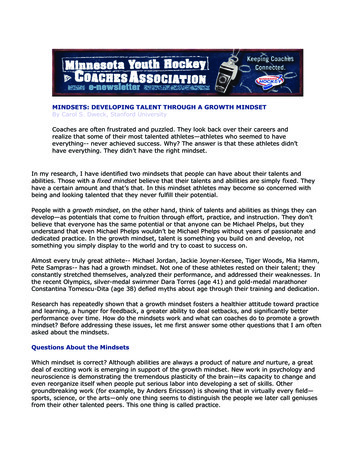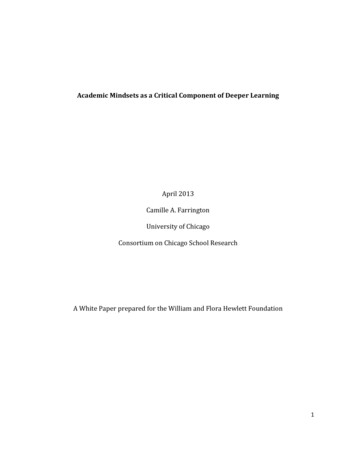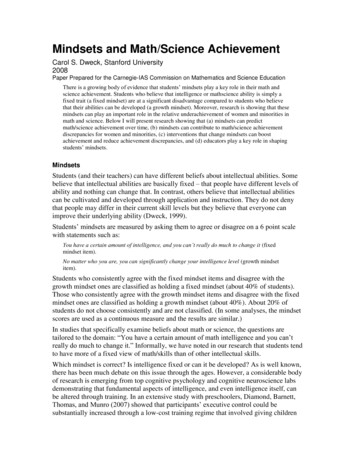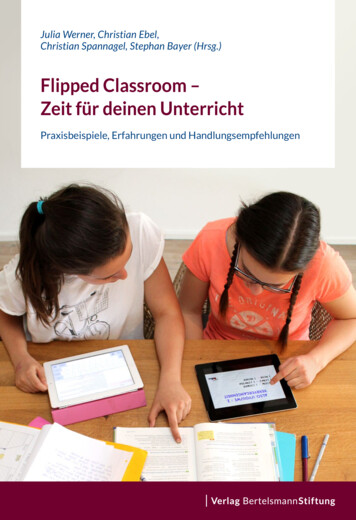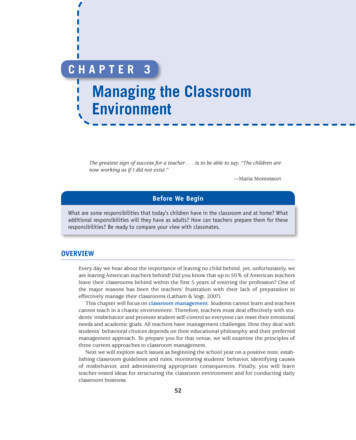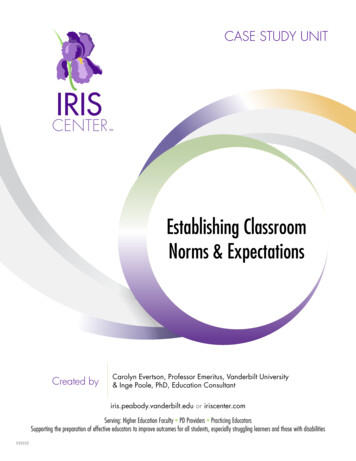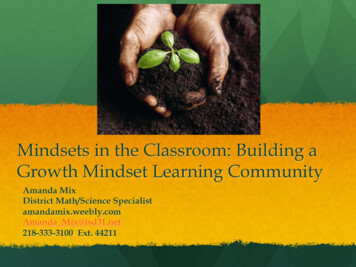
Transcription
Mindsets in the Classroom: Building aGrowth Mindset Learning CommunityAmanda MixDistrict Math/Science Specialistamandamix.weebly.comAmanda Mix@isd31.net218-333-3100 Ext. 44211
What are Mindsets, and How doThey Affect the Classroom?(Chapter 1) Growth Mindset: A belief systemthat suggests that one’sintelligence and/or talents can begrown or developed withpersistence, effort, and a focus oflearning. Neuroplasticity: The ability ofthe brain to change, adapt, and“rewire” itself throughout ourentire life. Fixed Mindset: A belief thatsuggests that a person has apredetermined amount ofintelligence, skills, or talents (I.Q.,“smart,” “math person,” “somekids are born smarter thanothers,” % Favor the word “yet.”110%90% Perseverance, grit, resiliency218%82%342%58% Process Praise vs. People Praise
What are Some Ways to BeginBuilding a Growth MindsetSchool Culture? (Chapter 2)Seven Steps:Growth MindsetResources:1.Reflect and Pre-assess2.Educate Staff about theMalleability of the Brain3.Educate Staff about Praise forStudents Growth Mindset Kits Info. atKhan f7VkjCekZJc4.Educate Teachers About theBrain Growth Mindset Kit Link:https://www.mindsetkit.org/5.Teach Students About the Brain6.Educate Parents7.Monitor, Evaluate, and ReviewSchool Protocols (PLC’s) Growth Mindset Resources th-mindsetresources
Why is a Differentiated, ResponsiveClassroom Important to a GrowthMindset Culture? Terminology, first! Differentiation: The way a teacherresponds to a student’s needs so thateach student is challenged at theappropriate level. Pre-assessments: Finding out whatstudents KNOW about a particularskill, concept, or topic before planningfor instruction. Curriculum Compacting: Aninstructional strategy that streamlinesgrade-level curriculum by eliminatingcontent that students have previouslylearned.Formative Assessment: Checking forunderstanding during the learningprocess in order to modify instructionto improve understanding; this is anassessment for learning. Anchor Activities: Ongoing tasksgiven to students that they canaccess when they completeclassroom work or when theirteacher is working with otherstudents and that enrich the learningof the content being studied. Acceleration: Moving faster throughcontent, allowing students who havealready mastered content quickly tomove into above-grade-level content. Enrichment: Learning with greaterdepth and breadth; going deep andwide into the content. Summative Assessment:Assessment of learning that typicallyoccurs at the end of a unit of study.
A Look at TwoAssessmentsFormative Assessment(for learning):Summative Assessment(of learning):When: Simultaneously whileteachingWhen: At the end of theselected time periodExamples: informal teacherquestions, informalobservations, rough drafts,reflection statements,checklists or rubrics,discussions, visualrepresentations, think-pairshare, learning logs, exit slipsExamples: final copy of anystudent work, teacher-madesummarizing assessments, endof unit compilation, portfolios,conferences, high-stakesstandardized tests (be carefulwith this!)
Why is a Differentiated, ResponsiveClassroom Important to a GrowthMindset Culture? (Chapter 3) Ask yourself, “What instructional structures are in place toguarantee a responsive learning environment?” Allow your students the opportunity to first “preview” thecontent being assessed. It helps to activate theirbackground knowledge (5 min. or less). When Developing a Pre-assessment:1.Provide multiple means of representation and expression(words and pictures).2.Don’t squeeze too many skills/concepts into one preassessment.3.Measure only what is being assessed.4.Use effective questions.5.If reading is not being assessed, read the pre-assessment tothe students.6.Do not count the assessments towards a child’s grade. Resources to Look at:1.Figure 3 (Guidelinesfor DevelopingPre-assessments forMath) on page 442.FormativeAssessmentExample (Figure 4)on page 553.The Frayer Model(Figure 5) on page56
Why is Critical ThinkingImportant in a Growth MindsetClass Culture? (Chapter 4)Critical ThinkingInvolves: Reasoning Making judgments/decisionmakingThe Critical Thinking Growth MindsetProject: Involves CCSS Math Practices (pg. 66). Involves teaching components (pg. 67) Results: Problem solving1. Students talked about determination,motivation, and persistence.Keep in Mind: The processmust be infused with content(involves perseverance andresiliency-the two mostimportant attributes to having agrowth mindset)2. There was an increase inencouragement, and students did not deterfrom setbacks.3. Thinking and working hard became aclassroom norm (believing in oneself).
How Can Students Learn fromFailure? (Part 1) (Chapter 5) “Students need to learn thatstruggle is a very importantpart of the learning process.Embrace the struggle” (pg. 76). “Academic resiliency cannot bedeveloped if students areunderchallenged” (pg. 76). Yes, failure can be a reward, forit is through failure that we canlearn the most” (pg. 76). (Meetthe Robinsons-Keep movingforward!) Attribution Theory: successfulpeople attribute to internalfactors, and unsuccessfulpeople tend to blame externalfactors (intrinsic vs. extrinsicrewards). Grades and growth mindsetare not a “happy marriage.”Grades emphasize the result,not the process (it is mastered,or it is not there “yet.”) Provide opportunities, time,and space for practice andfeedback.
How Can Students Learn fromFailure? (Part 2) (Chapter 5) We need to change how studentsreact to failure. True Grit Demonstrates anIndividual to:1. Pursue interests.2. Demonstrate the capacity toengage in deliberate practice.3. Have/Own a sense ofpurpose.4. Have/demonstrate hope. How to Develop Grit:1. Establish the environment.2. Set expectations.3. Teach the vocabulary.4. Create frustration(opportunities for struggle).5. Monitor the experience.6. Reflect and learn.*Sandpaper Reference (pgs. 86-89)
How Can Students Learn fromFailure? (Part 3) (Chapter 5) Destructive vs. ProductiveStruggle (pg. 90). Dos and Don’ts for ProductiveStruggle (Table 4 on page 92) Reasoning games (that help withproductive struggle): Types of Mistakes:1. Can engage in effortful thinking.1. Stretch mistake (embracechallenge)2. Take a problem-based approachto learning.2. Aha-moment mistake (achieved,without all the information)3. Learn by doing, learn by failing(safe to make mistakes).3. Sloppy mistake (rushed ordistracted)4. Allow for informative feedbackwhile students progress.4. High-stakes mistake (lifethreatening or performance-based)5. Allow for progressive growth.
What Messages Should ParentsHear About Growth Mindset?(Chapter 6) “A central message tocommunicate with parents isthe importance of encouragingresilience in their children” (pg.97). Suggestions:1. Use growth mindset praise.2. Model flexibility.3. Adopt a “glass half full”mentality in the home.4. Help children find their ownniche. Get feedback from parents. “Providing information toparents about the importanceof effort and persistence shouldbe ongoing” (pg. 103). “Children may, in fact, be thecatalysts for helping theirparents truly understand themalleability of the mind” (pg.103). Parent Letters (pgs. 201-205)
Can Gifted Education and aGrowth Mindset Belief Coexist?(Chapter 7) All students should have “accessto challenging curriculum andenriched learningopportunities” (pg. 106). “Responding to theinstructional needs of studentsat a young age is a nonnegotiable practice” (pg. 111). The label of “gifted” may causestudents to “not put in the worknecessary to sustain that talent may turn some children intostudents who are overlycautious and challengeavoidant” (pg. 107). Philosophy of gifted educationthat has adopted a growthmindset (pgs. 114-115). Students should be described as“high-potential learners” or“highly motivated.”* Notice how the word “gifted” isnot mentioned specifically (Insteadit is a teaching and learningphilosophy for all students.).
What are Some Ways to HelpStudents Adopt a GrowthMindset? (Chapter 8)Learning Sequence: Preview and Pre-assessment(Activate BackgroundKnowledge) Pre-assess Growth Mindset andFixed Mindset Introducing Growth MindsetTerminology (perseverance) Teaching Perseverance andResilience through MakerSpaces Facing Failure/TeachingOptimismSample Learning Tasks:1.The Brain is Like a Sponge(all Grade Levels-pg. 127)2.Building a Neural Network(pg. 130)3.The Brain is Like a Muscle(pg. 138)4.Taking Care of Your Brain(pg. 139)5.Collection Strategy (pg. 140)
What are Some Ways School StaffCan Maintain a Growth MindsetSchool Culture? (Chpt. 9) Creating a growth mindset classroom (safe place wherestudents do not feel judged and are free to take intellectualrisks) Coaching (non-evaluative feedback about instruction) Beware of the false growth mindset! Sample list of “look fors” (pgs. 172-173) Integrate the growth mindset across all subject areas.
Summary (Chapter 10) “The commitment to buildingand maintaining a learningenvironment where expectationsare high for all students,responsive instruction is thenorm, and where all studentsvalue effort and perseverance iswell worth the time” (pg. 175). “Educators teach students, notcurriculum” (pg. 176). “Remember that a growthmindset learning environment isa journey you will get therewith dedication and hardwork” (pg. 177). To have the most impact,teachers should:1. Believe all students can achieveand be successful.2. Teach students about neuralconnections and the value of effort.3. Apply differentiated,responsive instruction.4. Provide many critical thinkingopportunities.5. Broaden the definition of“giftedness” to “potential.”
Resources: Appendix A (pg. 193): Sample TrainingPlan for Staff Growth Mindset ProfessionalDevelopment Appendix B (pg. 201): Parent NewsletterBlurbs John Hattie’s Interactive e/hattie-rankinginteractive-2009-2011-2015.html
Creating a growth mindset classroom (safe place where students do not feel judged and are free to take intellectual risks) ! Coaching (non-evaluative feedback about instruction) ! Beware of the false growth mindset! ! Sample list of "look fors" (pgs. 172-173) ! Integrate the growth mindset across all subject areas.


